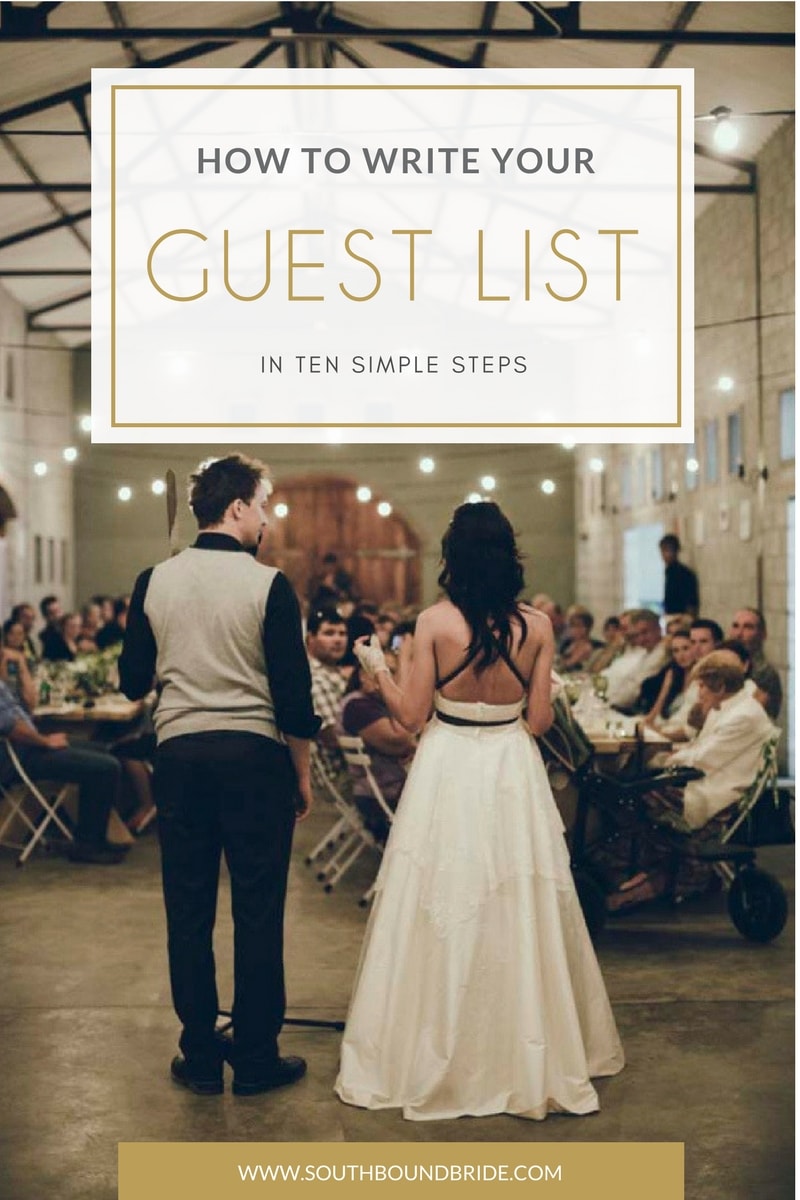Image: Jules Morgan on SBB
The title of this article was originally ’10 Easy Steps’, but I decided that was way inaccurate. Let’s be honest, choosing who can and can’t attend your wedding is never easy, right? It’s possibly the task you’re dreading most. And it’s true, there are a million little bits of information and wedding guest list etiquette to consider, and feelings that might get hurt, and complications that could (and probably will) develop. Nobody likes to be left out of stuff. But the good news is that if you follow a logical process to making your wedding guest list, step by step, and the ‘rules’ (which you make yourselves) are clear to your family, etc. then you’re far less likely to offend. And then you can get on with the fun stuff. So here it is, my ten step method for how to make a wedding guest list. Let’s go!
Step 1: Crunch the numbers
Before you even consider actual guests, sit down with your fiance and work out how many people you CAN invite. If you already have a venue in mind, check with them about capacity. If it’s a destination wedding, you might also need to consider accommodation. Think about the sort of wedding you want – is it a big blowout with hundreds of people, a medium sized bash, or an intimate affair with just your nearest and dearest? And of course, there’s the budget. Many elements of a wedding cost on a per-head basis, so work out how many of those you can afford. Once you’ve taken all those factors into account, work out a maximum number. And here’s the key: STICK TO IT.
Step 2: Consult the VIPs
One of the big complications in guest list planning comes from parental expectations, especially if either set are paying for or contributing to the wedding, so this is the time to sit down and work out what everyone’s thoughts are on the subject. Again, try to keep the discussion to principles rather than specific guests for the moment. These days, I don’t think the expectations are nearly as high for parents to invite ‘extras’ like business associates, distant family, etc. but your folks may see things differently, and if there’s a financial contribution on their part especially, you’ll need to take that into account. Your parents may be happy as long as immediate family members and close family friends are included, in which case there’s no dispute, but if both sets of parents insist on having their own guests, work out a split of the numbers that everyone can live with – perhaps one third each, or fifty percent to you as a couple and a quarter for each family. Try to ensure that sense prevails here – for example, if your husband-to-be is from a close, extended family and you’re an only child with few relatives, an even split will only mean that one side is inviting people they don’t really care about. However you do it, once the split is agreed to, make sure everyone knows the maximum number that they can invite, no exceptions. (Seriously, Mom-in-Laws of the world, no exceptions.)
Step 3: Make the rules
This is where you need to firm up the following:
- Will you have children at the wedding? Are everyone’s children included, or just those in the wedding party?
- Who gets to invite plus ones? I’d recommend including partners where the couple is married, engaged, living together or in an otherwise long-term relationship, but depending on your age and your friends’ circumstances, you might set a different rule.
- Are exes invited? The etiquette is generally: hell no, but of course you may have a drama-free relationship with an ex, especially if children are involved. I’d advise giving your bride or groom-to-be a veto here; basically, if they’re uncomfortable, don’t invite them.
I can’t stress this one enough – whatever you decide, BE CONSISTENT and stick to these rules. My mom is still offended by a family wedding where she was told not to bring me because children weren’t allowed, only to find lots of them running around. Whatever your rules are, there is a lot less room for hurt feelings if you apply them across the board.
Step 4: Make a dream list
Think of this as the brainstorming session. Write down everyone you can possibly think of who you might want at your wedding, if numbers and budget weren’t an issue. Go through your contacts, think back to the friends you have from different times in your life, include colleagues and distant relatives. This is one way of ensuring that you don’t forget anyone. Also, later on, if you suddenly start wavering over an acquaintance, go back and consult this list. If someone wasn’t on it, they definitely shouldn’t make the final cut.
Step 5: Divide it into categories
This is the part where I start to sound like an OCD freak, but bear with me, there’s method to my madness, and trust me – making a very subjective process just a little more clinical will keep you sane in the end. Take your dream list and break it down into categories. I suggest: immediate family, close friends, close family, friends you see fairly regularly, family friends, old friends you haven’t seen in some time, distant relatives, colleagues, and others. Rank those lists in order of importance. For example, would you rather have your distant relatives there than old friends? Or are you especially close to your colleagues?
Step 6: Group the categories
This is going to seem so mean, but here’s where you have to rank actual people. Sorry. Within each category, choose an A list (those people you cannot imagine NOT having at your wedding), a B list (the people you really, really want there), and a C list (the people it would be nice to have).
Step 7: Count ’em up
Add up your totals. If you’re lucky, there might be some neat (and obvious) cut-off points. First fill the available slots with non-negotiables – your immediate families and A list people. How many spots do you have left over? If you can include the whole of your B list, then do. Otherwise…
Step 8: Snip snip
This is the worst part, but just take a deep breath and dive in. You may be able to eliminate whole categories (for example, if you make a blanket rule of ‘no colleagues’, that’s a whole group cut, and they’re sure to understand if you say you’re keeping it to friends and family only). If not, remember your category ranking from earlier. For example, add B List ‘friends you see fairly regularly’ before ‘distant relatives’ if that’s the order you chose. Then when it comes to the crunch on individuals, here are some questions you can ask yourselves:
- Have I seen or talked to them in the last year? (Apparently Lauren Conrad used a rule here where if she hadn’t had a meal with someone in two years, they were off the list, which is a good alternative.)
- For colleagues, have you ever spent time together outside of work?
- Has your fiance ever met this person?
- Would or did this person invite you to their own wedding? (Reciprocal invites aren’t always a must though.)
- Would your wedding be the same without them?
- Are they likely to be in your lives going forward?
Step 9: Send the Save the Dates
Time to bite the bullet. Now here’s where it can get controversial. I know some people who invited their ‘first choice’ guest list initially and, when spaces came up, filled them with people who hadn’t quite made the cut before. You can usually expect around 20% of your invited guests to be unable to make it (although this doesn’t always hold true!) so this is an understandable tactic. The key thing is to do it early, and honestly. If someone came to me a few weeks after Save the Dates went out and said “we didn’t think we could include you because numbers are tight, but we’re so thrilled that we now can”, I absolutely wouldn’t be offended. But I once got an invite to a colleague’s wedding less than a week before, and that just felt rude and sloppy. Nobody wants to feel like rent-a-crowd.
Step 10: Damage control
So far so good, but yes, there may be some hurt feelings and tricky situations. Some folks may assume they’re invited and you’ll have to gently explain that they aren’t. People may assume their children or partners are included, when they aren’t. Family you haven’t spoken to since you were a child may get the huff. There’s no accounting for everyone, but clear communication, politeness and kindness are the best things to apply here. Make sure your invitation wording is clear if children are excluded, for example. Tell your favourite work friend how much you would have loved to have her there, but that you’ve had to make the decision not to include colleagues. Whatever it is, if you’ve clearly thought about it and made your decisions practically, people will usually understand. After all, it’s a lot less hurtful to know that you’re not on the guest list because it’s a small one, than thinking it’s because someone doesn’t really like you. A couple of things to keep in mind:
- Unless you’re planning a teeny tiny destination wedding or elopement, it’s super bad manners to invite someone to your showers or engagement party and not to your wedding. Way to make it seem like you’re just looking for extra gifts.
- Having a small wedding is the number one way to save money, so for budget brides and grooms, think bijou.
- Having a small wedding is also the best way to avoid very complicated family situations. Worst case scenario? Elope, and have a party afterwards.
And there you have it. Ten steps. Good luck!





